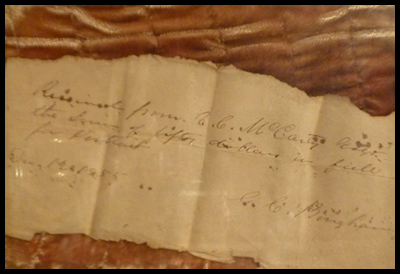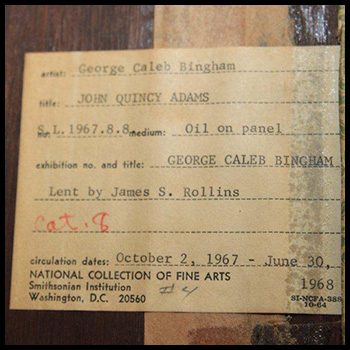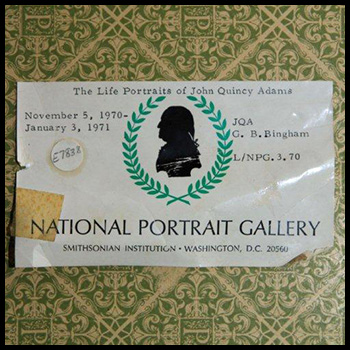Provenance
The definition of provenance is simple:
The history of the ownership of a work of art or an antique, used as a guide to authenticity or quality; a documented record of this. Oxford English Dictionary
Understanding the full meaning and uses of provenance is a bit trickier. Clear title, pedigree, chain of custody are all analogous definitions intertwined with value.
Clear Title
Who owned the picture last…and who before that. The ideal is to trace it right back to the studio.[1]
As a piece of property, an artwork needs a clear title. An essential piece in Nazi looting and indigenous repatriation issues is provenance research.
With 19th century American portraits, the best provenance is a dated receipt from the artist to the portrait sitter. In the example below, the receipt to E. C. (Edward Cresap) McCarty for $50 for payment in full for portrait is dated December 12, 1855, and signed by G. C. (George Caleb) Bingham. Because the owner has a record of each owner after E. C. McCarty, the receipt essentially traces the portrait “right back to the studio.” In this case, provenance provides “clear title.”

Pedigree
The establishment of the identity of successive owners since the portrait’s creation through any or all of the following:
- Published documents, including newspaper or magazine articles
- Catalogues
- Journals of the artist or others, that contain references to the painting
- Reproductions
- Exhibitions
- Sales records
- Correspondence that mentions the artwork, especially from the artist.[2]
Legitimacy
A panel of experts…declined to authenticate the canvas. Without knowing its provenance…they can’t be sure [the] find is legit.[4]
Of course, the flip side of pedigree is illegitimacy. If provenance does not exist, there is no chain of custody. At worst, unscrupulous activities could have occurred. At best, a perfectly fine painting by a perfectly fine artist is demoted to a piece of lesser value.
Provenance provides a clear title, a pedigree, and an assurance of trust and legitimacy.
I know what he’s after: a written statement about the clock’s condition and history. That sort of provenance affects the price in auction.[3]
One of the more fun projects for Fine Art Investigations was George Caleb Bingham’s original portrait from life of John Quincy Adams. The family kept a complete record of ownership as it descended in the family from one heir to the next. John Quincy Adams wrote of his sitting with Bingham in his diary. Stickers on the back of the painting verified its exhibition history. This “pedigree” ensured that the painting achieved the best possible price at auction.

George Caleb Bingham
John Quincy Adams, 1844
Oil on Panel, 10 x 7 inches, with frame

George Caleb Bingham
John Quincy Adams, 1844
Verso with exhibition sticker from Smithsonian American Art Museum from National Portrait Gallery

George Caleb Bingham
John Quincy Adams, 1844
Verso with exhibition sticker from Smithsonian American Art Museum from National Portrait Gallery
Footnotes:
1. Michael Innes, From London Far (Penguin Books, 1946; Reissue edition, 1976), 146 in OED.
2. John N. Barron, Language of Painting (The World Publishing Company, 1967), 156 in OED.
3. Len Deighton, Spy Line (Alfred A. Knopf, 1989), 208 in OED.
4. Joshua Davis, “Is This a Real Jackson Pollock?” Wired (July 1, 2003) in OED.
